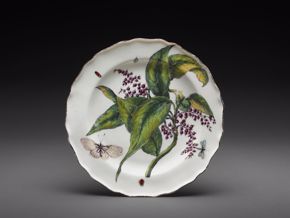Perpetual Bloom: Botanicals in the 18th-Century Interior March 10–July 31, 2021

Chelsea Porcelain Works, Plate, c. 1755, porcelain, the Museum of Fine Arts, Houston, the Rienzi Collection, Museum purchase funded by Mr. and Mrs. Harris Masterson III.
Worcester Porcelain Manufactory, Gardener and Companion, 1770, soft-paste porcelain, the Museum of Fine Arts, Houston, the Rienzi Collection, gift of Mr. and Mrs. Harris Masterson III.
Henry Fletcher, after Pieter Casteels III, January, from the series The Twelve Months of Flowers, 1730, engraving with etching and hand coloring on laid paper, the Museum of Fine Arts, Houston, the Bayou Bend Collection, gift of Miss Ima Hogg.
Worcester Porcelain Manufactory, Pair of Wall Pockets, 1754–55, soft-paste porcelain, the Museum of Fine Arts, Houston, the Rienzi Collection, gift of Mr. and Mrs. Harris Masterson III in honor of Mrs. William Cutter Hunt.
Bow Porcelain Factory, Sweetmeat or Pickle Stand, c. 1760, soft-paste porcelain, the Museum of Fine Arts, Houston, the Rienzi Collection, gift of Mr. and Mrs. Harris Masterson III.
Thomas Rowlandson, Elegant Figures in a Walled Garden, 1803–05, watercolor and ink over traces of graphite on wove paper, the Museum of Fine Arts, Houston, the Stuart Collection, Museum purchase funded by Francita Stuart Koelsch Ulmer in honor of the Garden Club of Houston.
Jacques Rigaud, The Rotunda at Stowe, 1733, pen and ink with gray wash on two sheets of laid paper, the Museum of Fine Arts, Houston, Stuart Collection, Museum purchase funded by Francita Stuart Koelsch Ulmer in honor of the Garden Club of Houston.
Rienzi, the MFAH house museum for European decorative arts, presents special exhibitions twice a year.
Throughout the 18th century, new ideas about nature, based on scientific discoveries and geographic explorations, resulted in extraordinary representations of the natural world in the visual arts. As European nations explored distant lands and established colonies in the Americas, South Africa, and Asia, botanicals flowed into Europe from all over the world.
Scientific discoveries and the new print culture helped fuel botanical study and the close observation of nature. These new discoveries ignited a craze for landscape gardens both in and out of doors. Perpetual Bloom explores the ways in which botanicals were displayed and re-created in domestic interiors during the 1700s. The exhibition features a variety of works, including porcelain, silver, and engravings.
Perpetual Bloom: Botanicals in the 18th-Century Interior | March 10–July 31, 2021
This exhibition is organized by the Museum of Fine Arts, Houston.
